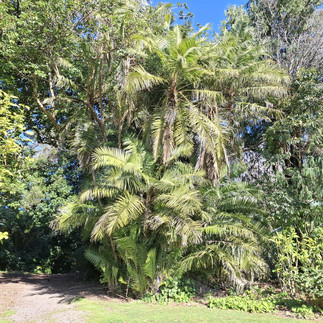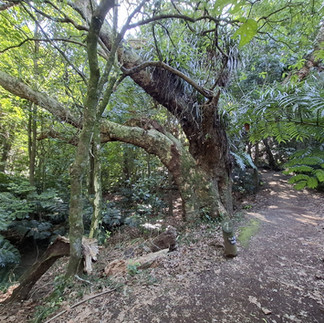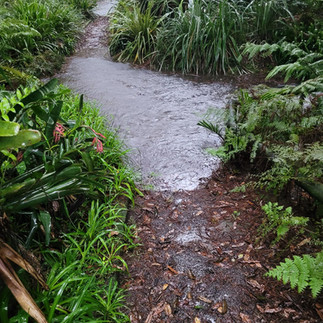

Members Lunch
Midday, Wednesday 15 October 2025
Member’s Lunch (High Tea)
Pukekura Tea House, Pukekura Park
The cost is $25 per head.
Please RSVP by Sunday evening 10 October to Alison – treasurer@pukekura.org.nz
To confirm your booking, please pay $25 by internet banking to:
TSB Acc Name: Friends of Pukekura Park New Plymouth Incorporated
ACC No: 15-3953-0539316-01
Please ensure your name is included and “Members Lunch”
If you are unable to pay this way, please contact treasurer@pukekura.org.nz
The Friends look forward to seeing you there.
Events Programme September 2025
2nd - Wanderers’ walk.
Bellringer Pavilion at 10.30am
Arborist talk and walk with Josh Paice NPDC arborist.
9th Committee meeting
16th - Wanderers’ Walk. - Lead, Tony Barnes
Leaving from Zoo Car Park at 10.30am
Tony is a well known horticulturist and gardener with his own garden being, Ngamamaku, on Ahu Ahu Road. A renowned camellia expert, Tony will have many fascinating insights to share with us – not to be missed!
25th Evening Meeting
Citizens Advice Bureau, next to the Y.M.C.A. - 7pm
Elise Smith. Two interesting gardens – Chelsea Physic Garden and De Hortus Amsterdam.
Review of June's Events
August 5th - Wanderers' Walk
Lead - Tony Burrell
16 of us braved the chilly morning, rugged up well and explored the Brooklands “old” nature walk.
Tony led us through the walk, noting differences (trees no longer there, new ones also) and we had detailed discussions on various trees as we went along.
When we reached Ambush Gully, down behind the Zoo… we were bombarded by a Kereru flying through us, then serenaded by a group of over active, over weight tuis. Such a noise but a joy to see them above us!
The cold meant we had to keep walking, no dawdling – a well worthwhile and enjoyable walk.
Trees of note we saw in Brooklands Park – Norfolk Pine, Datura, Kohekohe, Date Palm. And on the way back up to the top we marvelled at the Oregon Cypresses in all their splendour.
Thanks Tony
August 19th - Wanderers' Walk
Leads - Eve Cozzi and Maxine Jenkins
Eleven folks braved the weather for our zoo visit.
We met Eve Cozzi (zoo lead) inside the zoo. We started at the ground level viewing window of the capuchin enclosure giving us a bit of shelter from the rain. Eve told us about a recent capuchin birth, the sex of which is unknown. The young monkeys cling to their mother’s back for several months so it may be a while before the sex is known. We had to wait until it stopped raining before we saw any of the monkeys, but they did appear including the mother and baby.
We then went across to the meerkat enclosure where Maxine Jenkins (Brooklands Zoo Coordinator) talked about some of the quirky habits of the meerkats.
The fascinating aspect of both talks was the information about the feeding habits of the animals. It was explained that Zoo diets are designed with great care to support animal welfare across five key domains: nutrition, environment, health, behaviour, and mental engagement. These domains guide how food is selected, prepared, and presented to meet the unique needs of each species. Brooklands Zoo incorporates diets designed by larger, welfare accredited zoos that have onsite nutritionists as well as recommendations from their vets and experienced staff to ensure each diet is specific to each species.
Eve and Maxine explained that Nutrition is more than just feeding—it's about ensuring animals receive the right balance of nutrients for their age, condition, and natural habits. Environmental considerations include how food is offered, often in ways that encourage movement and natural behaviours. This might involve hiding food or using enrichment tools that stimulate curiosity and problem-solving.
Brooklands Zoos meerkats are fed small portions a minimum of five times per day as they would naturally spend most of their time foraging for food. Items such as vegetables, live insects, special commercial pellets, and meat items such as chicken necks are all parts of a healthy meerkat diet. Allowing them to find their own insects in rotten logs is a great way to encourage the use of meerkats strong claws to pull apart the wood and keeps them active.
Human quality fresh foods is provided to ensure optimum nutrition and keepers regularly weigh each animal to ensure they are a healthy weight. Behavioural welfare is enhanced by feeding in ways that promote natural instincts, such as foraging or hunting. Mental engagement is fostered by making feeding time interesting and varied, helping animals stay alert and engaged. Capuchin monkeys are extremely intelligent and need to be given their diet in challenging ways to keep them active and engaged. Diet items such as small seeds can be scattered through the whole habitat. Whole coconuts or walnuts can be given so the capuchins need to use stone tools or think of ways to crack them open. Contrary to popular belief, the zoo’s monkeys don’t get any fruit as its much higher in sugars and lower in fibre than wild fruits. Vegetables are closer to wild fruit and the zoo’s monkeys enjoy a wide variety, with kumara, carrots and capsicums being firm favourites.
Many thanks to Eve and Maxine for an extremely interesting visit.
July 28th - Evening Meeting
We were joined by a group of councillor and mayoral candidates running at the next local election. Each one spoke for 3 minutes to introduce themselves and share some thoughts on the Park. Following the speeches supper was served and we had a chance to speak to the people informally.
At the end of this blog is a summary of what each candidate said.
From the Zoo
Article By: Maxine Jenkins the Brooklands Zoo Supervisor
Keeping Track of Wildlife: How ZIMS Helps Accredited Zoos Like Brooklands Zoo Protect Animals
At Brooklands Zoo, caring for animals goes far beyond feeding and habitat maintenance. As a ZAA-accredited facility and a proud member of Species360, Brooklands Zoo is part of a global network using the Zoological Information Management System (ZIMS)—the world’s largest database of animals in human care.
ZIMS is used by more than 1,300 institutions across nearly 100 countries. It holds records on millions of animals from more than 22,000 species, including detailed data on birth dates, parentage, behaviour, and environmental needs. This information is essential for managing animal welfare, breeding programs, and conservation strategies.
Brooklands Zoo contributes to this global effort by maintaining detailed records on its animals, including cotton-headed tamarins, capuchin monkeys, and Bolivian squirrel monkeys. These records help ensure healthy gene pools and support coordinated breeding efforts across zoos.
Every animal housed within Brooklands Zoo is assigned a special number that will travel with it if it moves to another facility, ensuring all the information that has been recorded, travels with it. This can be very helpful for new keepers and veterinarians to ensure the continuing best welfare for that animal. Important information to collect includes weights, diets, interactions with other animals within its social group, medical treatments or procedures, training progress and much more.
Another key feature of ZIMS is its studbook system, which tracks genetic lineages and breeding histories in a similar way that pedigree cat or dog breeders do for their animals. This helps zoos manage sustainable populations and avoid inbreeding, supporting long-term conservation goals.
ZIMS also supports important research into animal populations and biodiversity. For example, it has been used to track global trends in species diversity across zoos and aquariums—insights that help shape conservation strategies and ensure the survival of endangered species. By participating in ZIMS, Brooklands Zoo is not only caring for its own animals but also contributing to a global mission: protecting wildlife for future generations.
Brooklands Zoo – Highly Pathogenic Avian Influenza (HPAI) preparedness by Eve Cozzi Brooklands Zoo Lead.
News about a highly contagious strain of bird flu might have dropped out of the headlines but a lot of work is still going on behind the scenes to be ready for it if it hits New Zealand.
Recently, Brooklands Zoo staff attended a Zoo and Aquarium Association workshop in New Plymouth – joined by staff from Rotokare Scenic Reserve, DOC Te Kuiti and Ōtorohanga Kiwi House – to share information about preparing for an outbreak.
There was also a site visit to Brooklands Zoo, where an expert cross-referenced the team's draft preparedness plan with what they saw on-site.
“We don't know exactly how HPAI will pan out if it gets here so having an expert review habitat set-ups has been really helpful,” says Brooklands Zoo Lead Eve Cozzi. “Our planning needs to be as robust as possible to protect both people and the zoo collection, while remaining fluid to change at a moment’s notice.”
To learn more information about avian influenza, check out MPI's website.

A Vet Specialist from Australia ran the workshops which consisted of two sessions:
Morning session – HPAI Biosecurity Planning was a policy and procedures session covering latest updates and our pre-prepared draft plans.
Afternoon session – Discussions on preparedness with a real-life facility layout while also covering various scenarios.
Meeting with NPDC Mayoral and Council AspirantsThursday 28 August 2025 at Citizens Advice Bureau
Attended: John Woodward, Peter Marra, Tina Koch, EJ Barrett, Ross Johnston, Gordon Brown, Nikki Truman, Greg Mackay, Sarah Sutherland, Moira George, Mike Morresey, Craig Tonkin, Sam Bennett, Sarah Lucas, Bryan Vickery
Apologies: Bill Simpson, Michael O’Sullivan, Amanda Clinton-Gohdes and Lani Hunt (plus FOPP members including Elise Smith and Judith Mullin)
40 people in total attended including some non-members.
Sue announced the apologies from the invited aspirants and gave a background to the aspirants and the Friends Members and how they assist in Pukekura Park. There are 12 Committee and Bryan Vickery is our representative from the NPDC.
There is two parts to the evening. Each aspirant will be given 3 mins with no questions from the floor. This to be done at the end one or one, when supper will be served.
Amanda Clinton-Gohdes is unwell and unable to attend and gave Sue a piece to read to those in attendance.
Alan Metcalfe reminded those present it is the Park’s 150th celebration next year.
John Woodward - Standing for mayor and councillor and is a first timer. Gave a brief rundown how his family had a connection to the Park with his elders in his family. The Park is an incredible asset and he enjoys spending time there with his family. He is Taranaki born and bred. Has his own business and been a member of NZ Police in the past. Wants to keep the Park as an asset for the future generations.
Peter Marra - Salutes all the volunteers in the Park. Is a cancer survivor and would like to see a ban on super phosphates. Last year he took people on tours (In Munich) and encouraged people to come to visit Pukekura Park. Hoping all the new councillors can work together to keep Pukekura Park. Has a vision to create tropical plants for food beside the fernery. Wishing us a long life with our vision for Pukekura Park.
Ross Johnstone - Dairy farmer retired from Manaia to New Plymouth in the last 10 years. Remembers as a child the ice creams in Pukekura Park and walking the dog. Amazed at how much is done by volunteers. Carried out 10.5 acres of planting river banks while farming. Wants to get tui and bellbirds back alongside the flora and fauna on the river banks. Has ideas for a new lake and Bellringer Pavillion upgrade for the 150th celebration. Encourages people to plant more in their own backyards.
Tina Koch - Taranaki born and bred. Favourite place growing up was going through Pukekura Park. Her six children have spent many years in the park utilizing it and feels it needs to be cherished. Has run the Seaside Market for the past 7 years. There is a need to support small business and a need to look after the Park for the future generations with water ways to be kept safe, clean and sustainable. Generations to come need to see the benefits we have experienced. It is a pride and joy for all visitors to Taranaki. Thanked the volunteers for the work they do.
Nikki Truman - Standing for the Kaitaki Ngamotu Ward. Would like to represent the Friends on Committee. Been in New Plymouth 30 years and is working at the Polytech. Her principles cover economic sustainability. We want to retain Pukekura Park but we don’t have the funds to maintain it. Need to fundraise to keep up this asset. Need environmental sustainability. Climate resilience needs to be built. Social sustainability. Everybody has been to Pukekura Park and it needs to be available to all people, with good lighting in winter and safe areas. It takes money to maintain it to keep the people coming to enjoy.
Sarah Sutherland - Only lived here a short time and had visited Pukekura Park before she lived here. Loves the fernery and children’s playground. Endorses what Nikki Truman has said. Wants to keep Pukekura Park as a treasure. We need to keep good relations between the Council and the park.
Gordon Brown - Served on the Friends of Pukekura Park Committee prior to Bryan Vickery. Referred to Adrienne Tatham being a past President who would keep the Committee on the ball to dealing with issues with the Park. First fell in love with Pukekura Park when he walked through the gates to the Cricket ground. It is one of the 6 most beautiful cricket grounds in the world. The late Rob Tucker, a great photographer, asked him to write a book and helped bring the park to life through his photography. George Fuller was the curator for 35 years and lived in the house in the Park. Pukekura Park is the jewel in the crown of New Plymouth. It was made by humans who made it all possible. Mess with the Park at your peril. Well done to the volunteers. Looking forward to the 150th celebrations.
Craig Tonkin - Standing for Kaitake Ngamotu Board. Moved to New Plymouth in 1977. His dad was a former radio announcer here. The Park has been a huge part of his life and very special part of his life. When he lived in Hamilton he told his friends they had to visit Pukekura Park. Came back here 3 years ago with his wife when his son joined the Army. Pukekura Park wants to continue the work his father started and visits the Park on a regular basis and standing for Council. Loves the mountain, the beaches and park. Has tattoos on his chest of all three. Thanked all the volunteers and appreciates the use of the features and facilities of the Park.
Sarah Lucas - Standing for Mayor and councillor for the Inglewood Board. Got on the Inglewood Board 3 years ago and loves being involved and has learned to listen to communities. Has chaired various community boards as a volunteer. Feels volunteers are the front line of the community. New Plymouth is a great place to raise families. Had a portrait taken in the Park when she was younger. Lived in Norman Street as a teenager. If elected wants to look at Parks and open spaces budget is opened to keep the Park sustainable. Thanked the volunteers of the Park and the community appreciates the work we do.
EJ Barrett - Running for Kaitake Ngamotu. Her passion is Libraries, homes and communities. Wants to maintain the public services that hold the community together. There is pressure to reduce services that we need. There are other ways this can be done. The Park is very important to her. Has used the Park literature re biodiversity in her studies. Her connection to the Park is wellbeing. In the past lived very close to the Park and was very sick being stuck in bed for months at a time. She pushed her bed up to the window so she could hear the birds from the Park as she lived in the street close by. It helped with her rehabilitation to breathe and walk with her walker. Thanks us for the space that we provide for everyone in New Plymouth.
Greg Mackay - Running for Mayor and wider council. Had a real big problem with Council with wasted moneys. Need to re-evaluate things to enable more to be put into Pukekura Park. His mother wanted to come here but couldn’t make it. , Thanks to Newton King otherwise we wouldn’t have a Park. Enjoyed the Park as a child and had a lot of fun there. Would like to see our Park go to natural fertilisers and sprays when required, to keep the rubbish out of the Park. It is a beautiful Park and brings his grandchildren here. Would like to see the Park preserved more in its native form. As a councillor, would like to see more financial input for the workers, volunteers, the cricket pavilion used more and the cricket pitch, even if only for school children and the next generation coming through. Would like to see more entertainment at the Bowl. We may get finance from that entertainment for the Park.
Sam Bennett - Supports all the other words said. Itemized annual costings on expenditure for the Parks in the area excluding staff wages. Asked those present if the Park is a need or want. Everyone agrees it is a need. He lives one min from the gate of the Park. He is Chair of an accessibility group in NPDC. 47% of our people are 65+ or with a disability. Has a responsibility to make it accessible for everyone. Will keep the investment in the Park. There is no monetary return but the emotional return is priceless. Vandalism is very upsetting which needs to stop and theft costs hundreds of thousands of dollars.
Sarah George - Talked about the early history of the creation of the Park. It was forward thinking at the time to transform the gulley into what it is today along with the community spirit. The park has received its 11th green award. Our dedication ensures the Park continues to thrive and grow. There are extensions from the Park including Brooklands Zoo and The Bowl. It has created a hub for community life. Council accounts do not separate out the costs from other Parks’ maintenance. Needs to see costs separated. Pukekura Park is an essential service for the well-being of the city. Maintaining the Park is essential.
Mike Morrisey - Acknowledged Shane Christie who lost his life yesterday. Standing for Kaitake/Ngamotu Ward. He is ex-military, serving his country to protect his country and town. Pukekura Park was his training ground, running and walking every track in the Park. It is well used by his family. Has been a Taranaki flag bearer for 25 years and earned the respect of the community and volunteers his time. He respects all the volunteers present tonight. Runs Hope Walk Charitable Trust for mental health. Put packs into schools in Taranaki for those that need the means.
Bryan Vickery - Thrilled with everyone who has attended. He deliberately chose not to be a part of the presentation. If everyone had his verb and passion for the Park it would be great. Gordon Brown told him to do a good job and smile. Needs people to be enthusiastic for the Park. Thrilled the aspirants are here. Their body language is great and are campaigning well. They have acquitted themselves and energized everyone in the room. Wishes the aspirants well.
Two other aspirants, Graham Chard and Peter Buis, were introduced to those attending although there was not time for them to speak to the Friends.
Those attending took the opportunity to mix and mingle over supper to ask questions and get to know each other better.
Friends of Pukekura Park Membership Application Form
To apply for membership, either click on the link to our website page or download a pdf application form
Copyright © 2024 Friends of Pukekura Park, All rights reserved.




















































































